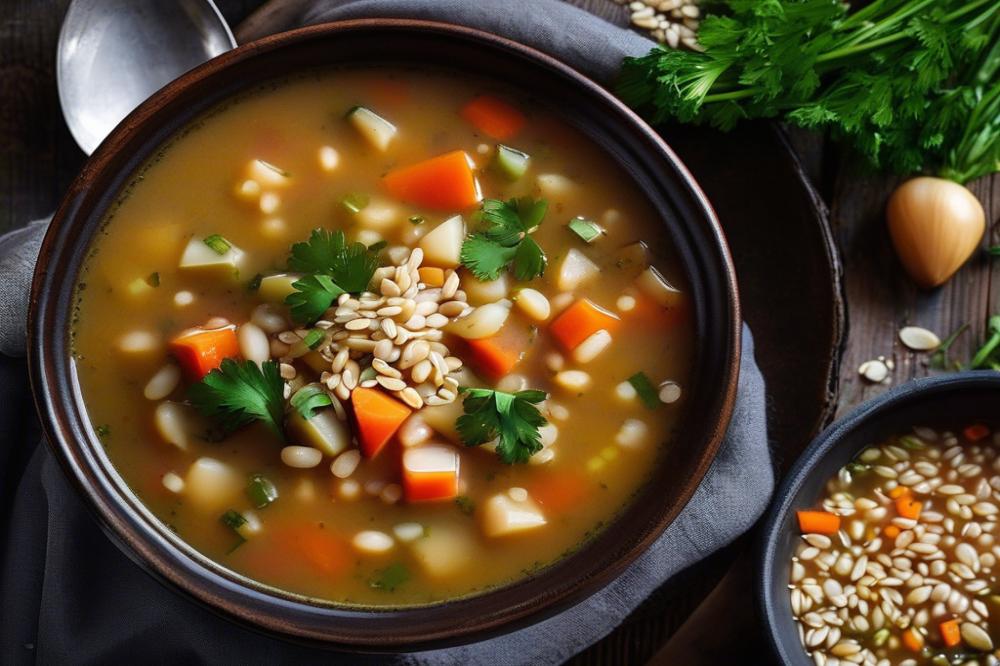Introduction
Feijoada à Portuguesa is a beloved Portuguese Bean Stew that embodies the heart of Portugal’s culinary traditions. This rich dish features a mix of black beans, meats, and a variety of spices, creating a hearty meal cherished by families across the country. traditional cooking methods in Portugal often focus on slow and flavorful preparations, allowing the ingredients to blend wonderfully.
In many Portuguese homes, this stew is more than just food; it represents comfort and togetherness. Family recipes passed down through generations bring a personal touch to each bowl served. Cooking feijoada is often a communal experience, where loved ones gather around the kitchen and share stories while preparing the meal. Such moments create lasting memories, reinforcing the importance of this dish in Portuguese culture.
This bean stew, often featuring sausages alongside various cuts of pork, showcases the diversity and richness of Portuguese recipes. Its warmth and depth of flavor make Feijoada à Portuguesa a staple during gatherings, especially in colder months. For many, enjoying a bowl of this stew is like wrapping oneself in a cozy blanket, evoking feelings of home and belonging. Whether served at celebrations or simple family dinners, it holds a special place in the hearts of those who savor it.
Understanding Feijoada à Portuguesa

Origin and Historical Significance
Feijoada à Portuguesa is more than just a recipe; it is a reflection of Portuguese culinary tradition. This hearty meal has roots that trace back to Portugal’s history. In the past, households would use leftover meats, making it an efficient way to minimize waste. Over time, this bean stew evolved. Families began to pass down their feijoada recipes through generations, making it a cherished part of many home kitchens.
Variations in Portuguese Regions
Different regions in Portugal showcase their own twists on this beloved dish. For instance, in the northern areas, local ingredients like smoked sausages and regional beans may be used. The Alentejo region favors using robust flavors, often leaning towards spices. Around Lisbon, people might prefer a milder version, focusing on the quality of the beans and less on the meats. Each small variation carries distinct tastes reflective of local culinary traditions.
Comparison with Other Bean Stews
Feijoada stands out among other bean stews, particularly when compared to versions from countries like Brazil or Spain. While Brazilian feijoada is known for its rich use of a variety of meats, the Portuguese version emphasizes the harmony of black beans and sausage stew. The preparation methods can also differ. In Portugal, a slow-cooking process allows flavors to meld beautifully. This patience ensures a deep, comforting flavor in the final dish.
Role of Feijoada in Cultural Gatherings and Celebrations
Celebrations in Portugal often feature this stew, embodying a sense of togetherness. Family gatherings and holidays are not complete without a pot of feijoada simmering on the stove. This comfort food is associated with sharing and abundance. People often recall childhood memories tied to the meals enjoyed at special events. Thus, feijoada contributes to building connections among friends and loved ones, reinforcing its importance in Portuguese culture.
Ingredients for Feijoada à Portuguesa

When preparing this traditional bean stew, gather a list of ingredients that highlight the rich flavors of Portuguese recipes. This hearty meal features black beans as the star ingredient, providing not just taste but also nutrition.
- 500g black beans
- 200g chorizo sausage
- 200g smoked sausage
- 150g bacon
- 1 large onion, chopped
- 4 cloves garlic, minced
- 2 bay leaves
- 1 teaspoon paprika
- Salt and pepper to taste
- Fresh parsley for garnish
The black beans serve as the foundation for this flavor-packed dish. In addition to protein, they are rich in fiber, making them a nutritious choice. With 339 calories per 100g, they offer a substantial base. Chorizo sausage brings a smoky and spicy element to the stew. Each serving contains approximately 452 calories and a good amount of protein.
Smoked sausage adds depth to the meal, with around 400 calories per 100g. This provides an additional layer of flavor that complements the beans perfectly. Bacon contributes a delightful crunch and savory taste, offering about 541 calories for every 100g used in the recipe.
Next, the onion and garlic create an aromatic base. Onions have roughly 40 calories for one large bulb, while garlic offers only 149 calories per 100g. These ingredients elevate the stew and enhance its complexity. Bay leaves infuse a subtle earthiness, and their calories are negligible in the context of the overall dish.
Finally, salt and pepper are crucial for seasoning. Both enhance the flavors of the other ingredients. Paprika adds a colorful touch, with around 282 calories per 100g. Garnishing with fresh parsley not only brightens the dish but also adds minimal calories.
Understanding the nutritional information of each ingredient can deepen your appreciation for this family recipe. This sausage stew embodies comfort food and celebrates culinary traditions.
Cooking Instructions for Feijoada à Portuguesa

Step-by-step method of preparation
Start by soaking black beans overnight. This helps them become tender and enhances their flavor. Use enough water to cover the beans completely. After soaking, drain and rinse the beans to remove excess salt and impurities.
Next, sauté diced bacon and various sausages in a large pot. These meats add depth and richness to the dish, creating a base for the stew. Cook them until they are browned and some fat has rendered.
Then, incorporate chopped onion and minced garlic into the pot. Sauté these until they become translucent. This melding of flavors is crucial for the overall taste of the bean stew.
Once the onion and garlic are soft, add the drained black beans along with spices. Common spices include bay leaves, paprika, and black pepper. Stir to combine everything well, allowing the seasonings to coat the beans.
Finally, pour in enough water or broth to cover the mixture. Bring it to a boil, then reduce the heat and let it simmer. Cook until the beans are tender. This process can take a few hours, but patience pays off. You’ll know it’s ready when the beans are soft and the flavors meld beautifully.
Tips for achieving optimal flavor
For the best taste, consider using smoked meats. They add a wonderful depth to the stew. Additionally, trying out different sausages can customize the flavors. Don’t rush the cooking. The longer it simmers, the better the flavors. Periodically taste and adjust seasonings as necessary.
Suggested pairings and side dishes
Feijoada pairs wonderfully with steamed rice. This classic combination makes a hearty meal. Sliced oranges provide a refreshing contrast to the rich stew, cutting through the heaviness. You can also serve it with cornbread for a comforting twist. A simple green salad can brighten the meal, bringing freshness to the table.
These traditional cooking methods result in a deliciously filling dish. People often cherish family recipes like this one, passed down through generations. Enjoy crafting this Portuguese Bean Stew, rooted in culinary traditions that warm the soul.
Health Benefits of Feijoada à Portuguesa

Nutritional Value of Black Beans
Black beans are a star ingredient in many Portuguese recipes, including the famous bean stew. They are rich in protein, fiber, and various vitamins. This legume helps in digestion, thanks to its high fiber content. Eating black beans can also keep blood sugar levels stable. They provide essential minerals like iron and magnesium, supporting overall health. Their dark color signals a high level of antioxidants. These compounds can help protect against various diseases.
Importance of Protein from Meats
Meats used in the stew bring vital protein to the table. Sausages, pork, and beef add a hearty flavor while supplying important nutrients. Protein helps in building and repairing tissues in the body. Including these meats also contributes to a feeling of fullness. This is especially important in traditional cooking, where hearty meals are celebrated. A variety of meats ensures a balance of flavors and textures, enhancing the eating experience.
Benefits of Spices Such as Paprika
Spices play an essential role in any feijoada recipe. Paprika, commonly used, adds a wonderful depth of flavor. This spice can help with circulation and digestion. Its vibrant color makes the stew visually appealing. Other spices, like bay leaves and garlic, also contribute to health benefits. They help to boost the immune system and promote overall wellness. This adds not just taste but also nutritional value.
Hearty Meal Aspect and Satisfying Fullness
Feijoada à Portuguesa is more than just a meal; it is comfort food at its best. It warms the soul and fills the belly. The combination of black beans and meats creates a filling dish that can satisfy anyone. Friends and family often share this hearty stew during gatherings, making it part of culinary traditions. Preparing this dish can bring everyone together, reinforcing ties among loved ones. It’s a great way to enjoy good food while also gaining health benefits.
Variations and Personalization
Feijoada à Portuguesa is a dish that invites creativity and personal touches. Home cooks often venture off the traditional path, making it their own. Possible ingredient substitutions can include different types of beans or meats. While black beans are commonly used in a classic bean stew, pinto beans or even chickpeas might be an interesting swap for those seeking variety.
Regional adaptations often reflect local tastes and available ingredients. In some parts of Portugal, the dish may feature different types of sausage. While some recipes call for chorizo, others might use linguiça or smoked sausage. This subtle change enhances the flavor profile and offers a glimpse into local culinary traditions.
For those wanting to create a dish that accommodates dietary preferences, consider making a vegetarian or vegan version. Swapping out meat for hearty vegetables like eggplant, mushrooms, and zucchini can create a satisfying stew without sacrificing flavor. Using smoked paprika can replicate some of that smoky taste, ensuring the stew remains flavorful and rich.
Incorporating seasonal ingredients adds freshness and extra nutrition to any feijoada recipe. During the summer, for instance, adding fresh tomatoes or corn can brighten the dish. In colder months, root vegetables like carrots or parsnips not only enrich the flavor but also contribute to the comfort food aspect of this hearty meals classic.
The Final Thoughts
Cooking Feijoada à Portuguesa starts with gathering the right ingredients. Preparing the meats and vegetables requires some effort but brings rich flavors together. Slowly simmering the dish allows the ingredients to blend beautifully. Once it’s ready, the aroma fills the kitchen with warmth. Serving it with rice and orange adds a lovely touch.
This dish represents comfort in many ways. It holds the ability to bring people together around the table. Each spoonful tells a story of tradition and love. Enjoying a bowl can remind you of home-cooked meals and family gatherings. Many cherish this stew not only for its taste but for the memories it evokes.
Exploring traditional Portuguese recipes can be an exciting adventure. There’s a world of flavors waiting to be discovered. Each dish, with its history and method, offers a glimpse into another culture. Trying new recipes can inspire creativity and new family favorites. Who knows what hidden gems are waiting in your kitchen?
Considering how food connects us, sharing your culinary adventures can be rewarding. Talk to family members about their recipes and cooking methods. Every family has its own version of beloved dishes. These experiences strengthen bonds and keep traditions alive. Your journey with food can become part of your own legacy.



